Blogs

What Are Hardness Material Definitions? A Comprehensive Overview
Introduction
In the ever-evolving landscape of material science, hardness emerges as a pivotal property that dictates the performance and reliability of materials across diverse applications. From automotive components to non-sparking tools utilized in explosive environments, understanding hardness is essential for procurement managers who strive to ensure safety and efficacy in their material selections.
This article delves into the intricacies of hardness, exploring its:
– Definition
– Various testing methods
– Critical relationship between hardness, toughness, and strength
As advancements in testing methodologies continue to reshape industry standards, a comprehensive grasp of these concepts not only enhances product quality but also mitigates the risk of material failures. By navigating through the complexities of hardness testing, procurement professionals can make informed decisions that align with their strategic objectives, thereby driving excellence in material performance.
Defining Hardness: An Overview of Material Properties
The hardness material definition describes the capability of a substance to withstand deformation, particularly in the form of permanent indentation or scratching. This property is crucial in assessing how different substances behave under stress, particularly in demanding environments like automotive, electronics, and explosive settings where Non-Sparking Tools are essential. These tools provide a safe alternative in settings with explosive potential, ensuring that procurement managers can prioritize safety alongside performance.
The hardness material definition is determined through established evaluation methods that measure a substance’s resistance to mechanical forces, resulting in a numerical value. For instance, Knoop toughness testing can be conducted with loads ranging from 10 gf to 1,000 gf, illustrating the precision involved in these assessments. Grasping toughness is essential for efficient substance selection and quality control, affecting characteristics such as durability and wear resistance.
Moreover, suppliers and producers of high-temperature substances, including mica tape products, play a vital role in supplying the essential resources for these uses. As the sector moves forward to 2024, continuous improvements in durability assessment techniques, including the incorporation of machine learning models, are transforming our methodology in material science. A significant study released in Materialia emphasizes the theoretical prediction of Vickers strength for oxide glasses, demonstrating the use of a machine learning model, interpretability analysis, and experimental validation.
Furthermore, Hugh Rockwell, co-founder of the Rockwell indentation test, remarked, ‘Although originated as a concept in 1908 by a Viennese professor, Paul Ludwik, the Rockwell indentation test did not gain commercial significance until approximately 1914…’ This historical viewpoint highlights the development of material testing methods. Ultimately, acknowledging the influence of toughness in practical uses, especially concerning Non-Sparking Tools and the significance of dependable suppliers, is crucial for procurement managers aiming for excellence in product performance.
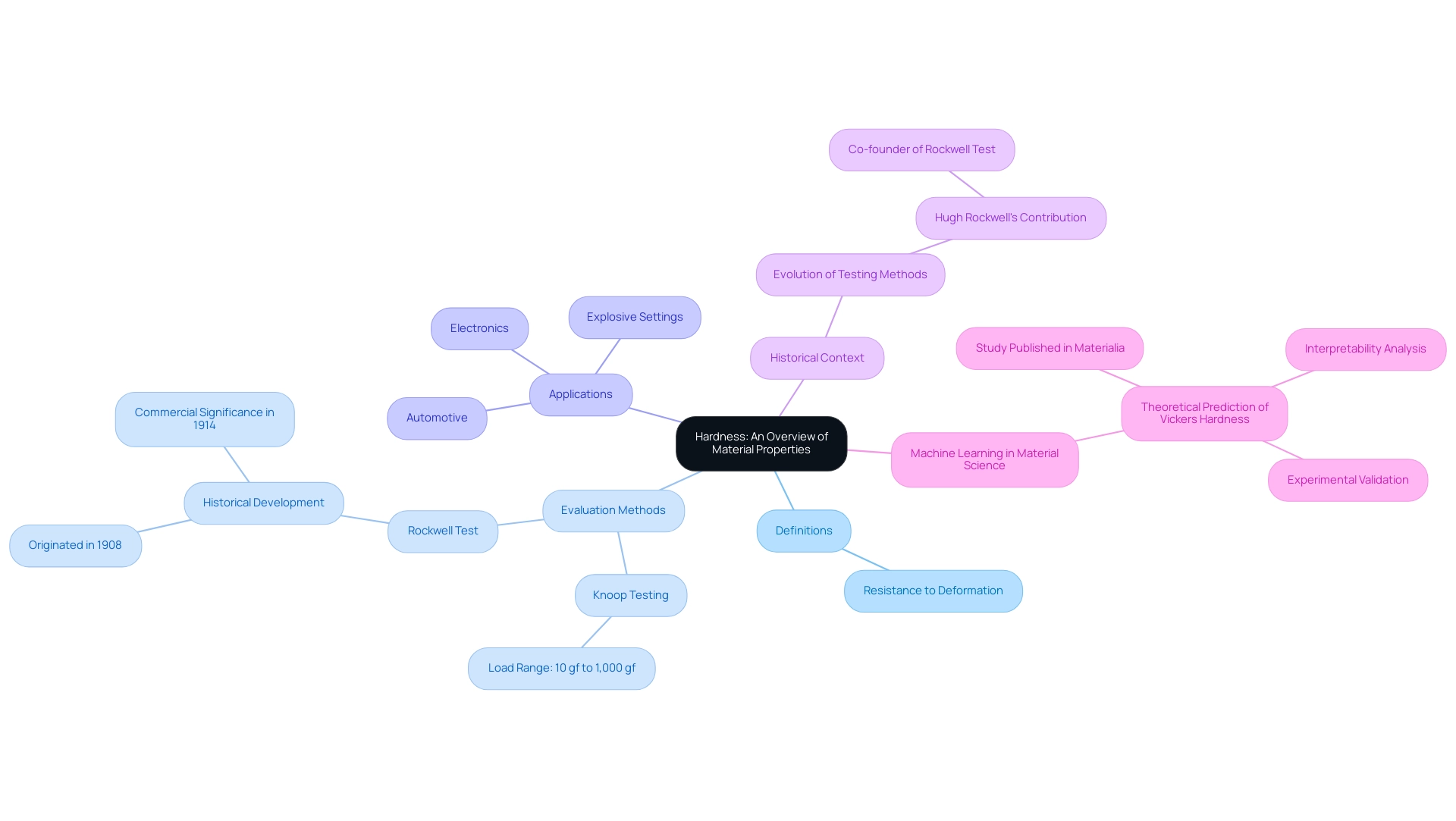
Exploring the Types of Hardness: Indentation, Scratch, and More
Different techniques are available to assess the hardness material definition of substances, with each customized to fulfill particular application needs and substance properties. A comprehensive understanding of these methods is crucial for procurement managers tasked with sourcing materials that align with performance specifications. According to the hardness material definition, the primary types of hardness measurement include:
Indentation Hardness: This method quantifies the depth of penetration made by an indenter under a designated load.
It encompasses well-established tests such as Rockwell, Brinell, and Vickers, which are widely utilized in the industry. As noted by Steve Ferry, Manager at Hauser Laboratories, > Samples that are electropolished prior to microhardness testing yield the most accurate results <, underscoring the significance of surface preparation in achieving reliable outcomes.Scratch Hardness: This approach evaluates a substance’s resistance to scratching, commonly assessed using the Mohs scale, which ranks minerals based on their scratch resistance.
This metric is particularly relevant in applications where the hardness material definition is critical for the durability of the substance.Rebound Toughness: This method assesses the rebound height of a ball dropped onto a substance, providing insights into solidity without causing surface damage.
It acts as a useful substitute in situations where maintaining the quality of the substance is crucial.
Comprehending the hardness material definition along with these durability assessment techniques is important for making knowledgeable choices about substance selection, which can greatly influence the effectiveness and responsibility linked to substance specifications. Mistakes in microhardness evaluations can result in incorrect specifications and possible liabilities, highlighting the necessity for precision in these assessments. Moreover, industry data suggest that the market for firmness assessment techniques is anticipated to expand at a CAGR of 6.1% during the forecast timeframe, demonstrating the rising dependence on precise firmness evaluation and the hardness material definition in procurement strategies.
For example, a recent case study named ‘Particle-Scale Characterization for DEM Simulations’ emphasized the significance of appropriate substance selection through advanced characterization methods, illustrating how precise hardness evaluation can confirm substance performance in practical applications.
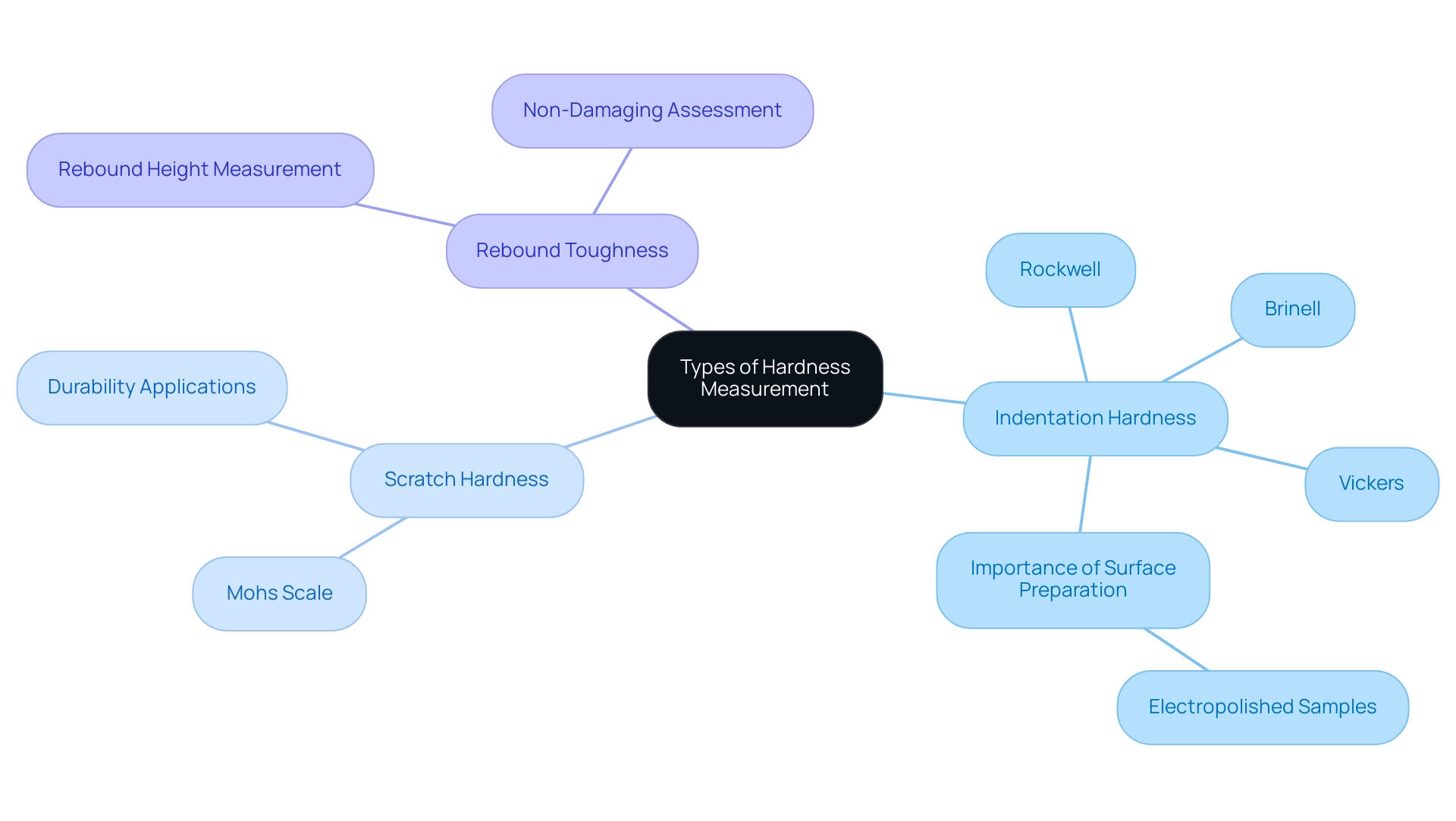
The Significance of Hardness Testing in Material Science
The hardness material definition indicates that hardness evaluation is a cornerstone of substance science, serving as a crucial indicator of a substance’s performance under stress. It is particularly vital in quality control processes, ensuring that materials conform to specified standards before they are utilized in production. For example, within the automotive industry, the ability of components to endure mechanical wear is paramount for both safety and durability.
Proper techniques, including adherence to proper indent spacing rules to avoid strain hardening effects, are essential for enhancing the accuracy and utility of the results obtained from Rockwell evaluation. The Knoop test mandates that the two halves of the long diagonals differ by no more than 10.0%, which is critical for reliable outcomes. As observed by Xiuping Jiang, Application and Laboratory Manager with a PhD in Material Science, the significance of the hardness material definition in firmness assessment for quality control cannot be overstated.
It significantly influences the selection of substances according to the hardness material definition, enabling engineers and procurement specialists to choose those that will perform optimally in their intended applications. Moreover, strength evaluation proves essential in failure investigation; it acts as a means for identifying the root cause of early substance or component failures. By examining strength test outcomes, engineers can pinpoint deficiencies in substance selection and direct design improvements or manufacturing modifications to avert future failures.
By thoroughly grasping durability, experts are enabled to make knowledgeable choices that not only improve product quality but also reduce the chance of failure.
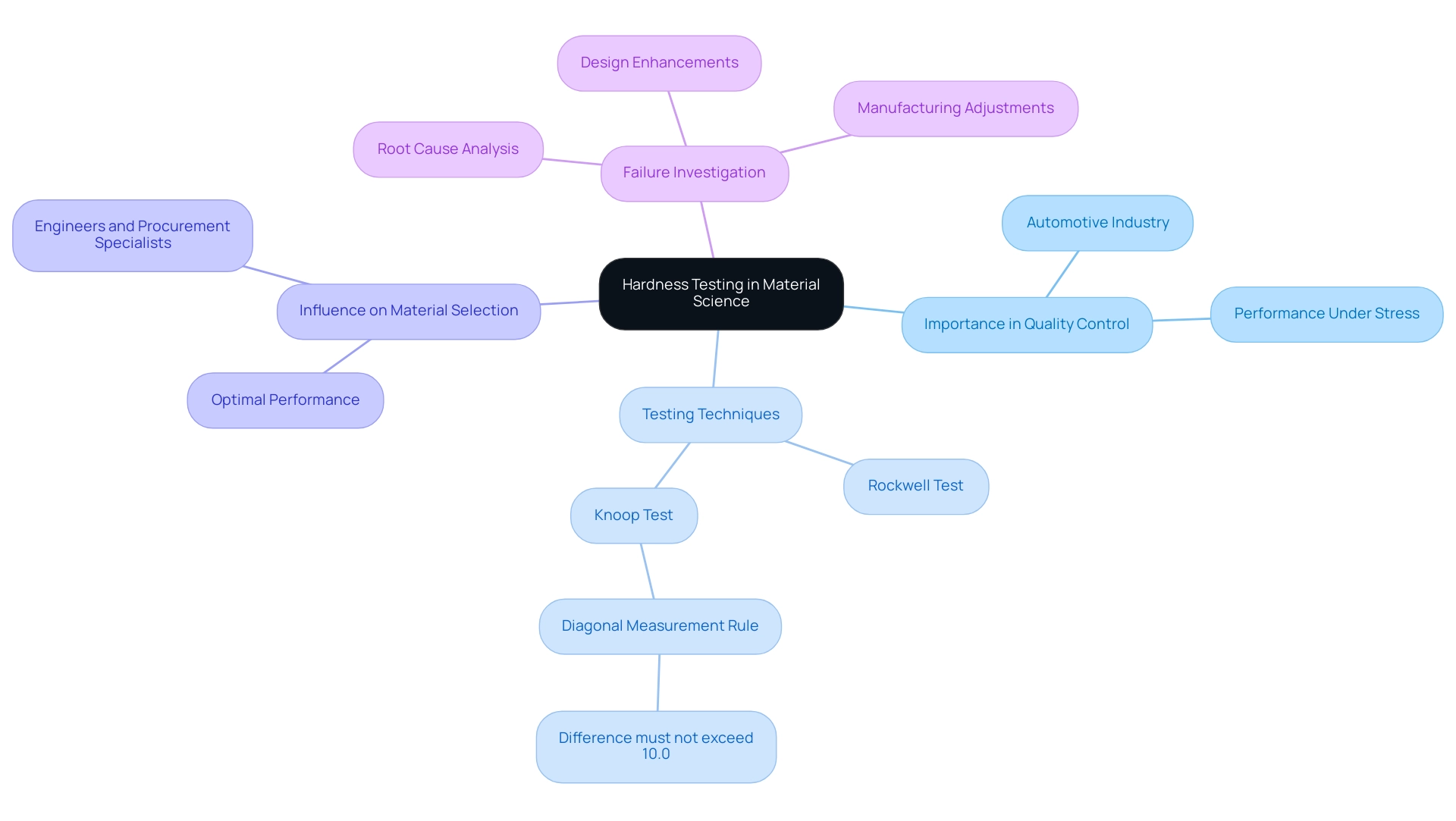
Methods of Hardness Testing: Techniques and Standards
Hardness testing is a critical aspect of material evaluation that helps in understanding the hardness material definition, employing several established methods that follow strict international standards to guarantee consistency and reliability in results across laboratories.
- Rockwell Hardness Test: This prevalent method evaluates the resistance by measuring the depth of an indentation produced by a specified load. The process involves applying a larger load followed by a smaller one, yielding a quick and dependable hardness value. Recent advancements in Rockwell testing have led to improved accuracy and efficiency, making it a preferred choice in various manufacturing settings.
- Brinell Hardness Test: This method employs a steel ball indenter, pressing it into the surface to measure the diameter of the resulting indentation. It is particularly effective for substances with coarse or uneven structures, ensuring reliable readings up to 450HB. The Brinell test creates a standardized method for evaluating the hardness material definition of various metallic substances, as demonstrated by multiple case studies illustrating its use in manufacturing processes. For example, a case study named “Hardness Test According to Brinell” demonstrates how this technique effectively assesses the firmness of different metallic substances.
- Vickers Hardness Test: Renowned for its versatility, this assessment employs a diamond indenter and is suitable for a wide range of substances. It offers a constant range of toughness values, which is useful for contrasting various substances. Significantly, a tensile strength of 2500 N/mm² relates to a Vickers toughness of 920, demonstrating the test’s capacity to provide accurate data across different uses.
- Knoop Hardness Test: This method is similar to the Vickers test but is specifically intended for brittle substances or thin layers. It creates a smaller indentation that minimizes damage, making it suitable for delicate samples. This durability test is especially appropriate for extremely small and very tough samples, increasing its significance in specialized uses.
Comprehending these methods and their applications is crucial for procurement managers aiming to ensure quality and performance as defined by the hardness material definition. A recently created cross-reference table for the Brinell, Rockwell, and Vickers tests improves this understanding, enabling simpler comparisons and knowledgeable decision-making in selection of substances. Additionally, Stahlhandel Gröditz GmbH’s participation in HYDROVISION International 2024 highlights the ongoing engagement and relevance of these testing methods within the industry.
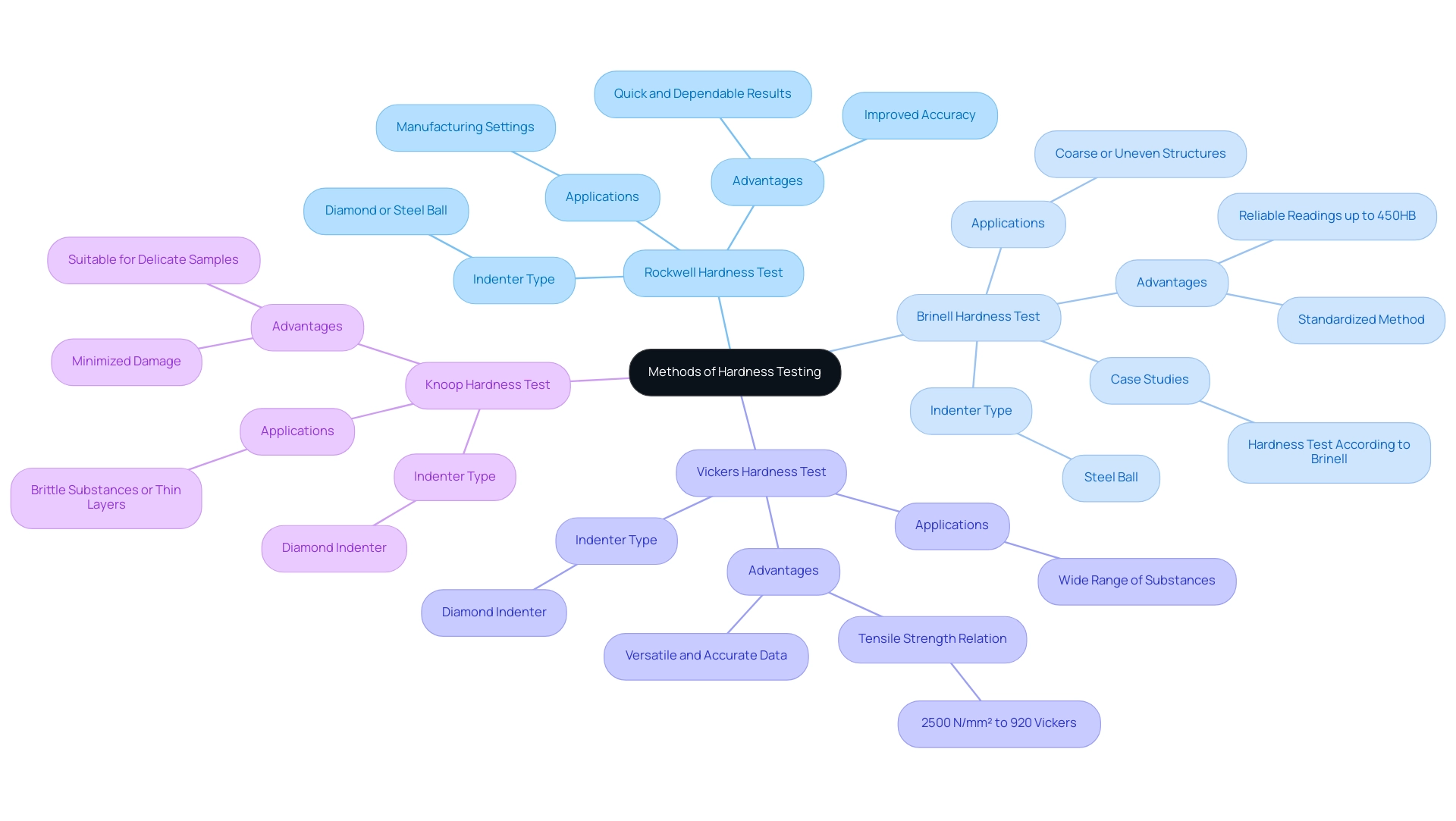
Understanding the Interplay Between Hardness, Toughness, and Strength
The interaction between hardness, toughness, and strength is essential in the realm of science concerning substances, particularly when evaluating uses in explosive environments. The hardness material definition is the measurement of a substance’s resistance to deformation, indicating how well it can withstand surface indentation and wear, which is critical for Non-Sparking Tools—considered the best alternative for non-sparking uses in explosive potential environments. Such tools are essential in these settings where preventing sparks is paramount.
In contrast, toughness measures a substance’s ability to absorb energy and undergo plastic deformation without fracturing—a crucial attribute in applications subject to impact or stress. Strength indicates the maximum load an object can withstand before failure occurs. It’s essential to acknowledge that a substance may display significant rigidity yet lack resilience, making it susceptible to fracturing under pressure.
Conversely, a tough substance may sacrifice hardness, leading to increased wear over time. For example, in vehicle-related uses, the choice of substances must involve a delicate balance of these properties to ensure both safety and performance. Recent studies indicate that, in printed mild steel (ER70S), no significant difference in yield strength was observed between vertical and horizontal specimens, highlighting how processing conditions can significantly influence properties.
Additionally, research on oxygen-free copper, such as DOMADIA Oxygen Free Copper (OFE/OHFC), indicates that different severe plastic deformation techniques, like High Pressure Torsion (HPT) and Equal Channel Angular Pressing (ECAP), can affect recovery behavior and mechanical properties. This comprehension is essential for procurement managers when choosing components for critical medical uses that demand specific substance characteristics. Furthermore, Mica Tape Products offer high-temperature resistance and electrical insulation, demonstrating how diverse processing conditions in substances like stainless steel 304 can result in locally optimized mechanical properties.
As highlighted by industry expert Random Engineer,
Toughness = Energy required to form a crack
This comprehensive understanding empowers procurement specialists to make informed decisions when selecting materials that align with the hardness material definition and also possess the requisite toughness and strength tailored to their specific applications.
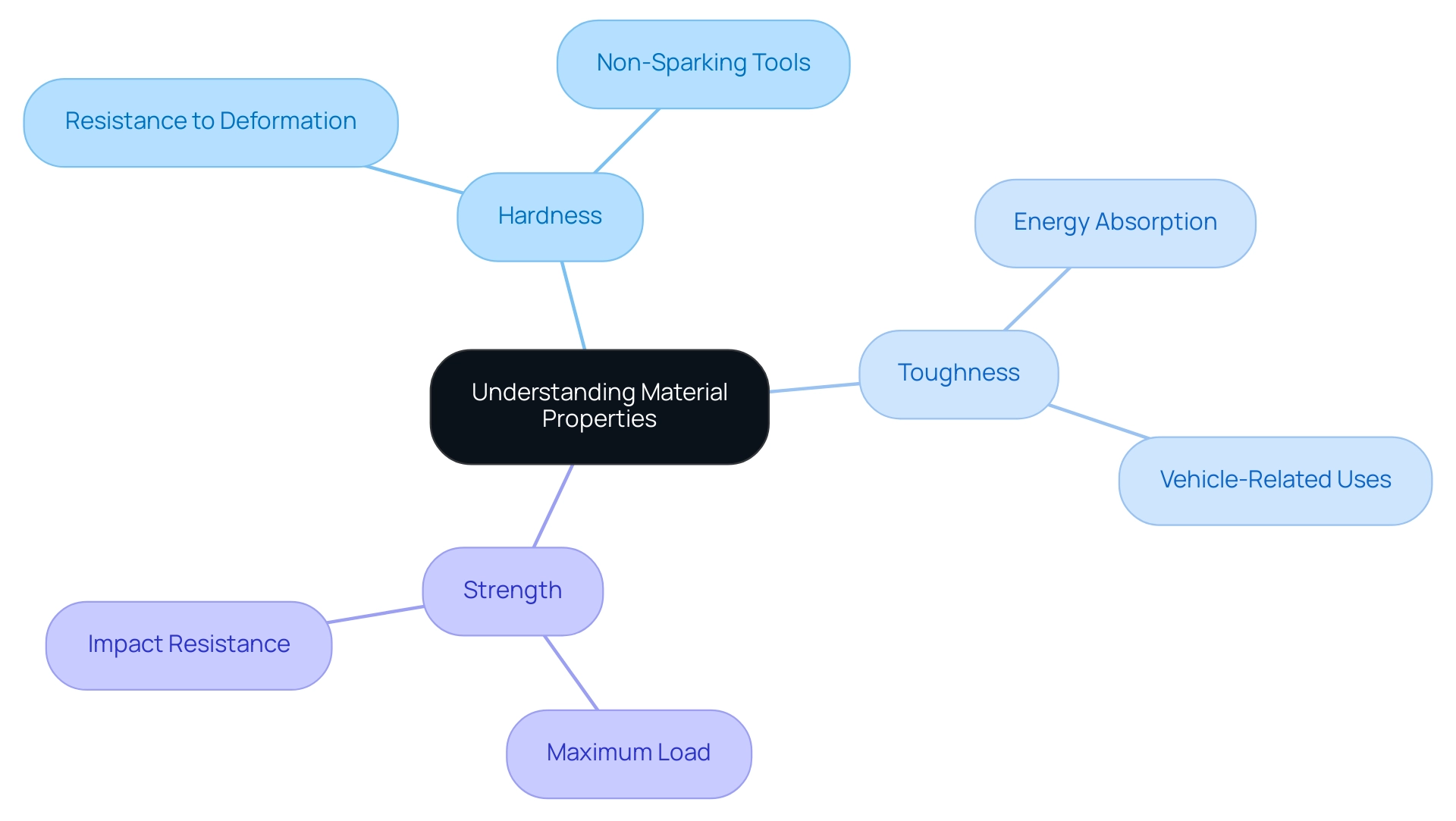
Conclusion
Understanding hardness is essential for procurement managers navigating the complexities of material selection in today’s dynamic landscape. This article has explored the definition of hardness, its various testing methods, and the critical relationship between hardness, toughness, and strength. Each of these aspects plays a pivotal role in determining material performance and reliability across a range of applications.
The examination of hardness testing methods, including indentation, scratch, and rebound hardness, underscores the importance of selecting the appropriate technique based on specific material characteristics and application requirements. With advancements in testing methodologies, such as the integration of machine learning models, procurement professionals can leverage these innovations to enhance product quality and mitigate risks associated with material failures.
Moreover, the interplay between hardness, toughness, and strength highlights the necessity of a balanced approach when selecting materials, particularly in high-stakes environments like automotive and medical applications. A comprehensive understanding of these properties enables procurement managers to make informed decisions that ensure both safety and performance.
In conclusion, mastering the intricacies of hardness and its testing methods positions procurement managers to drive excellence in material performance, safeguarding against potential failures while optimizing the quality of their selections. As the industry continues to evolve, staying abreast of these developments will be crucial for achieving strategic objectives and maintaining a competitive edge in material science.




